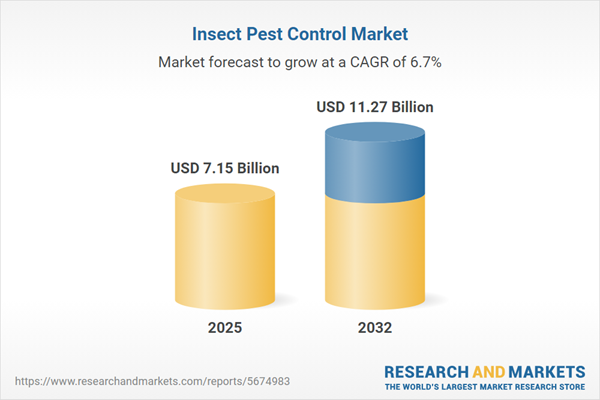Speak directly to the analyst to clarify any post sales queries you may have.
Senior executives in the insect pest control industry are facing rapid regulatory transitions and heightened sustainability requirements. As operational and compliance pressures intensify, updated strategies focused on innovation, monitoring technologies, and integrated solutions are becoming essential for market resilience. This research provides decision-makers with the clarity needed to navigate evolving conditions and drive strategically sound outcomes.
Market Snapshot: Insect Pest Control Market Size and Growth Prospects
The insect pest control market achieved a total value of USD 6.71 billion in 2024, expanding to USD 7.15 billion by 2025 with a projected USD 11.27 billion by 2032. Growth is sustained by a compound annual growth rate (CAGR) of 6.69%. Increased adoption of digital monitoring platforms, alongside a shift to eco-friendly pest management approaches, is reshaping sector priorities. Key decision-makers—serving agriculture, commercial, public health, and residential markets—prioritize integrating technology, achieving regulatory compliance, and meeting the rising demand for sustainable outcomes. This rapid pace of market evolution underscores the critical role of proactive adaptation and operational innovation.
Scope & Segmentation: Strategic Structure of the Insect Pest Control Market
This report equips executive teams with actionable insights to help mitigate risks, identify opportunities, and build robust long-term strategies through a comprehensive examination of the market’s structure:
- End Users: Sectors including agriculture, healthcare, hospitality, logistics, and residential property management receive focused analysis to clarify operational risks and sector-specific implementation requirements.
- Treatment Methods: Evaluation of biological (microbials, biochemicals), chemical (neonicotinoids, pyrethroids), and physical (thermal, barrier) pest control methods highlights effectiveness, compliance considerations, and adaptability in sustainable management.
- Pest Types: Analysis covers operational nuances for major pests such as ants, mosquitoes, flies, bed bugs, termites, and cockroaches to inform tailored risk mitigation strategies.
- Formulation Types: Assessment of application forms like gels, baits, dusts, sprays, foggers, and traps addresses efficiency and flexibility for diverse operational scenarios.
- Modes of Application: Details on indoor and outdoor pest control support alignment with local regulatory environments and performance optimization.
- Geographies: Coverage spans the Americas, Europe, Middle East and Africa, and Asia-Pacific, aiding strategy development in line with local policy and emerging market trends.
- Key Companies: Profiles of industry leaders including Bayer AG, BASF SE, Corteva, FMC Corporation, Syngenta International AG, UPL, Sumitomo Chemical, ADAMA Agricultural Solutions, Nufarm Limited, and Marrone Bio Innovations facilitate benchmarking in innovation and competitive strategy.
Key Takeaways: Strategic Insights for Senior Decision-Makers
- Integrating digital technology and biological controls allows organizations to balance sustainability and regulatory compliance while adapting operations to shifting requirements.
- Employing diversified pest management measures strengthens organizational resilience, supporting agile responses to regulatory and operational change.
- Strategic use of biological, chemical, and physical controls enables the development of integrated management models for operational effectiveness and responsible practices.
- Optimizing supply chain processes enhances operational consistency, giving organizations flexibility to accommodate new regulatory or logistical demands.
- Collaboration among manufacturers, regulators, and technical specialists advances access to predictive analytics and earlier detection, supporting evidence-based decisions.
- Enhancing compliance protocols positions companies more clearly in the market and supports integrated risk management for sustainable growth.
Tariff Impact: Navigating Cost and Supply Chain Uncertainty
With new U.S. tariffs set for 2025, organizations are re-evaluating sourcing and distribution models. Securing alternative supplier agreements and strengthening domestic manufacturing capacity helps offset potential disruptions. Companies are leveraging diversification—especially through the adoption of biological and physical pest control solutions—to maintain market stability and reinforce risk management.
Methodology & Data Sources
This analysis reflects insights from executive-level interviews, regulatory bodies, technical experts, academic research, comprehensive industry studies, and proprietary market models. By drawing on these sources, the research offers an integrated and authoritative perspective on current and future market dynamics.
Why This Report Matters: Benefits for Senior Leaders
- Supports the strategic realignment of pest control programs in response to fast-changing regulatory, operational, and geographic conditions.
- Delivers practical segmentation and in-depth regional perspectives to strengthen investment decisions, supply chain management, and overall competitiveness.
- Anticipates upcoming technology shifts and supply chain developments, enabling formation of resilient, evidence-based operational strategies.
Conclusion
This industry report empowers leadership teams with focused, actionable analysis for navigating ongoing regulatory, technological, and market changes. Senior decision-makers will gain the knowledge to adapt with confidence in today’s evolving insect pest control landscape.
Additional Product Information:
- Purchase of this report includes 1 year online access with quarterly updates.
- This report can be updated on request. Please contact our Customer Experience team using the Ask a Question widget on our website.
Table of Contents
3. Executive Summary
4. Market Overview
7. Cumulative Impact of Artificial Intelligence 2025
Companies Mentioned
The companies profiled in this Insect Pest Control market report include:- Bayer AG
- BASF SE
- Corteva, Inc.
- FMC Corporation
- Syngenta International AG
- UPL Limited
- Sumitomo Chemical Co., Ltd.
- ADAMA Agricultural Solutions Ltd.
- Nufarm Limited
- Marrone Bio Innovations, Inc.
Table Information
| Report Attribute | Details |
|---|---|
| No. of Pages | 198 |
| Published | November 2025 |
| Forecast Period | 2025 - 2032 |
| Estimated Market Value ( USD | $ 7.15 Billion |
| Forecasted Market Value ( USD | $ 11.27 Billion |
| Compound Annual Growth Rate | 6.6% |
| Regions Covered | Global |
| No. of Companies Mentioned | 11 |









